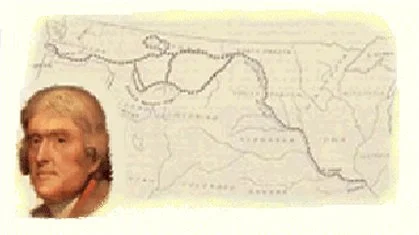Visitors Guide to Lewis & Clark Sites
in the Middle Mississippi River Valley
Trail of Tears State Park
Jackson, Missouri
greatriverroad.com’s coverage of the Corps of Discovery Expedition begins in the south where the Mississippi River meets the Ohio River and ends with coverage of historic St. Charles, Missouri. Included are the two national sites along the Lewis and Clark National Historic Trail in Hartford, Illinois and St. Charles, Missouri. greatriverroad.com also covers Eastern Legacy sites such as Fort Kaskaskia and the Cahokia Courthouse. Additionally, we have included many of the sites that have been selected by the Illinois and Missouri Lewis and Clark Bicentennial Commissions. Finally, we have added several sites that were not recognized by any of the above official organizations but that we feel that provide insight into the Expedition and enhance the visitor's experience. The sites on this page are not a full list of Lewis and Clark sites in the states of Illinois and Missouri.
Page 1 of 3
Sites are listed in a general chronological and a general geographical (south to north) order.
Fort Defiance Park - The Confluence of the Ohio and Mississippi Rivers
Cairo, Illinois
On November 14, 1803 Captain Meriwether Lewis noted in his journal that “this evening landed on the point at which the Ohio and Mississippi form there junchon.” The Corps of Discovery stayed for six days at the confluence of the Ohio and Mississippi Rivers one of the longest stops made by the expedition. The captains noted the mistletoe on the large timber and to their surprise, caught a 128 pound blue catfish. Their stay allowed Lewis to teach Captain William C. Clark the use of the navigational equipment; a compass and sextant. Because the 3rd Principal Meridian begins at the mouth of the Ohio, astronomical observations at this point were crucial.
Fort Jefferson
Ballard County, Kentucky
The journal kept by Lewis indicates that the Corps of Discovery spent the night of November 14, 1803, at the junction of the Ohio and Mississippi Rivers, near present day Cairo, Illinois, where they remained until November 20. During these days the two Captains tried to determine the best location for establishing a military fort. They also each spent time taking astronomical readings to determine latitude and longitude, and on November 18 they “Set out early this morning with a canoe and eight men in company with Capt. Clark to visit and view the ground on which Oald Fort Jefferson stood;” Fort Jefferson was established in 1789 by George Rogers Clark, the older brother of William, naming it for Thomas Jefferson, then governor of Virginia. The fort was abandoned the next year.
Bird's Point
Mississippi County, Missouri
Lewis and Clark first set foot on Missouri soil at Bird’s Point on November 16, 1803. Here the captains encountered an American settlement and “a great many” Shawnee and Delaware Indians. Today, a wayside offers a dramatic view from the Missouri side of the meeting of the Mississippi and Ohio Rivers. An interpretive exhibit about Lewis and Clark is located at the Henry S. Whipple Park in nearby Charleston.
Tywappity Bottom Interpretive Marker
Scott County, Missouri
On November 22, 1803, Lewis and Clark noticed a cluster of American settlements on a thickly wooded bottom known as Tywappity Bottom on the Missouri bank. Lewis saw an 8-foot, 2-inch tall horsetail plant growing in this lush bottom. As the expedition passed the upper end of Tywappity Bottom, where Commerce is now located, Lewis and Clark noticed a “handsome farm.”
Cape Girardeau
Cape Girardeau County, Missouri
On November 23, 1803, Lewis and Clark arrived at Cape Girardeau, a trading post established in 1795 by Louis Lorimier, the Spanish-appointed Commandant of the Cape Girardeau District. Here, Lewis, co-commander of the expedition, left the keelboat to pay an official visit to Commandant Lorimier. The remaining party, under the command of Clark, who was feeling ill, continued upstream about two miles and camped on a point of land that was the site of Lorimier's original trading post, which was probably constructed in 1793. Lewis would have dinner with the Lorimiers after “The Comdt. pressed me to stay to supper which I did, the lady of the family presided, and with much circumspection performed the honours of the table.”
Trail of Tears State Park
Cape Girardeau County, Missouri
After the Corps of Discovery party pushed off early on the morning of November 24, 1803, and Lewis soon noticed “some high clifts the summits of which are crowned with pitch-pine & seader, these rocks are nearly perpendicular in many places sixty feet, and the hight of the hills apear to be about 120 feet above the bank…” The Corps camped for the evening near today’s Trail of Tears State Park. This park features an overlook with a spectacular view of the Mississippi River and trails that lead through thick forests like those that Lewis noted in his journals.
LaRue-Pine Hills Research Natural Area
Union County, Illinois
While Lewis noted in his journal on November 24, 1803 of the high bluffs on the Missouri side he also made the following observation about the Illinois side: “the other appearing low and subject to be overflowed for a considirable distance say 2 or three miles…" Visitors today can explore the wilderness that is similar to that the Corps of Discovery experienced.
Tower Rock, Perry County, Missouri
Grand Tower, Jackson County, Illinois
On November 25, 1803 Lewis and Clark “Arrived at the Grand Tower a little before sunset, passed above it and came too on the Lard. shore for the night.” The next day Lewis described Tower Rock made of “limestone & the same quality of the clifts heretofore described” and that there were “strong courants thus meeting each other form an immence and dangerous whirlpool which no boat dare approach in that state of the water…”















